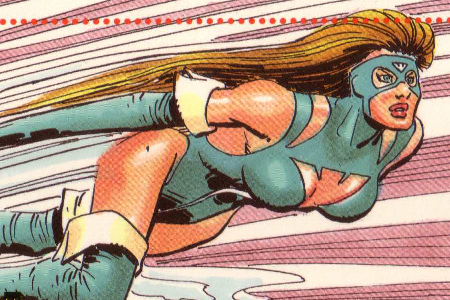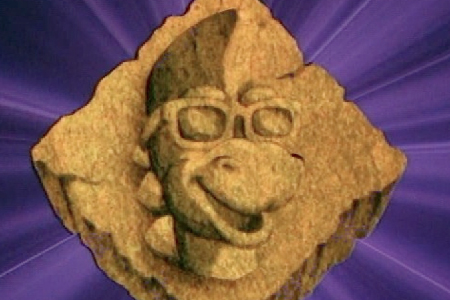 I’ve only been creeped out by art twice in my life. And both times, it was awesome.
I’ve only been creeped out by art twice in my life. And both times, it was awesome.
My born-in-the-’80s comrades will probably confirm that the illustrations from the original Scary Stories to Tell in the Dark series were the catalyst for at least one memorable nightmare or sleepless night. Eyes at the foot of the bed, people. You know what I’m talking about. The second time I was creeped out by art was while looking at the surrealist hellscape painted on the side of a funhouse in Wildwood, NJ. The art in the former was terrifying because Stephen Gammell, a Caldecott-winning illustrator, is a master at his craft. The art on the funhouse walls, however, was haunting for other reasons, and not just because New Jersey’s own native endless hellscape stretched into the distance behind the funhouse. You’d never have thought that so many “Come At Me, Bro” tanktops could even exist on one sad planet, but they’re all in Jersey.
The airbrushed demons, subtle gore and the weird, infernal scenarios drawn out on the funhouse weren’t painted on there with any kind of masterful skill, nor did they bear evidence of any professional training or awareness of fundamental artistic principles. They weren’t technically elaborate, and they didn’t really reflect any of the cliches of “horror” culture, which is generally predicated on movie monsters and folklore. Instead, these funhouse creatures seemed to exist because this was what someone saw when they closed their eyes, whether they liked it or not. These demons existed completely independent of what anyone else might find scary. These were demons that fought to get out of someone’s troubled mind, whether or not they knew how to draw. Again, byproduct of living in Jersey? We’ll never know.

In this very special way, the genre of “horror” art is wholly owned by the creative amateur or outsider. When you’re not mired in trained technique, there’s an honesty in whatever technique you do use to express yourself. While a professional, carefully-honed artist can draw a scary picture, it’s often the amateur that expresses the emotion of fear more honestly and directly, and sometimes desperately, in their visual works. The Art of Living Dead Dolls is perfect evidence of this.
This isn’t an encyclopedia of existing Living Dead Dolls and their surprisingly diverse appearances, but instead a collection of art made by fans, with every art piece based on different characters from the incredibly wide swath of LDDs, each with their own name, theme and personality. While the title implies that the book would be about, perhaps, the creative process and visual inspirations of these dolls, Mezco instead includes the fans directly in the world of these dolls. The title doesn’t say this is it art ‘about’ Living Dead Dolls, after all. Instead, it’s all-inclusive, making the fans just as much a part of this as the company’s own artists.
Mezco‘s Living Dead Dolls have been mass-produced since 2001, and prior to that, were handcrafted as early as 1998. Before that, the subject of broken, deformed and re-contextualized baby dolls lived in just about every art classroom that had at least one goth student. (Goth is what we used to call “Emo”, kids, except we didn’t post whiny shit on Tumblr ’cause the Internet hadn’t ruined humanity yet and we had better music. We were able to cultivate real, healthy loneliness, not this “post my no-one-loves-me crap on Instagram for my followers” nonsense.)

When you were a teenager, desperately trying to shed the skin of being an innocent little kid, the edgiest and most obviously metaphorical thing you could legally do was to deface a doll. Not a year passed at my high school when a kid with a Nine Inch Nails or Marylin Manson obsession didn’t make some kind of messed-up babydoll art somewhere in an art show. During one particularly controversial year, roadkill was used. When it comes to natural resources, I think that upstate New York thrives in the roadkill department. Roadkill and apples and dirty overalls.
Defaced and deranged dolls are a medium that disaffected youth flock to. The Art of Living Dead Dolls feels like going back to my old high school, and that’s a nice feeling. While there are some very established professional artists featured herein, like artist-of-many-spooky-things Dan Brereton, much of the book feels like those glorious funhouse walls. Many of these artists are finding their feet, and they’ve laid their inspirations bare here for this book. If you’re an illustrator, which I realize is a title that doesn’t apply to a particularly large group of people, you’ll see yourself in these pages. A section of “fan art” at the end of the book makes a strange delineation between that particular section of art and all that came before it, as it feels clear that everyone participating is a pretty big fan of these dolls, and is collectively neither more or less adept at expressing themselves visually. The introduction by legendary horror illustrator Basil Gogos seems to agree: these new guys are going somewhere.
The Art of Living Dead Dolls is a well-curated snapshot of fans of a specific line of collectible art toys, and I always find that interesting. Exploring subcultures by what they create is a really beautiful way to explore what the community is about; you can show off collections, but they’ll all have the same stuff. Show how those collections have influenced the collectors and you’ve struck gold. This book is a quick look into a group of people who could provide a very immersive fan experience.
[Review product was graciously provided by Mezco.]
 C. David is a writer and artist living in the Hudson Valley, NY. He loves pinball, Wazmo Nariz, Rem Lezar, MODOK, pogs, Ultra Monsters, 80s horror, and is secretly very enthusiastic about everything else not listed here.
C. David is a writer and artist living in the Hudson Valley, NY. He loves pinball, Wazmo Nariz, Rem Lezar, MODOK, pogs, Ultra Monsters, 80s horror, and is secretly very enthusiastic about everything else not listed here.








